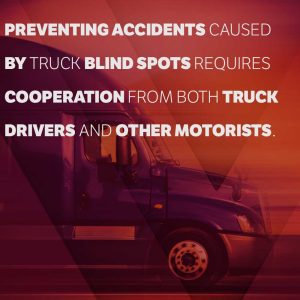
What you will learn from this article:
- What truck blind spots are and where they are located on large commercial trucks.
- How truck blind spots contribute to accidents, including lane change accidents, rear-end collisions, right-turn accidents, and unsafe passing.
- The importance of consulting with an experienced attorney specializing in truck accidents if you’ve been involved in a truck blind spot accident and the steps to seek compensation for injuries and damages.
The roads are a complex web of vehicles of all shapes and sizes, each with its own set of challenges. Among these, large commercial trucks can pose unique risks to both truck drivers and other motorists. One significant factor contributing to accidents involving trucks is their blind spots. In this blog, we’ll delve into what semi truck blind spots are, how they can lead to accidents, and the measures that can be taken to prevent these potentially catastrophic incidents.
What Are a Truck’s Blind Spots Called?
Before we explore the implications of truck blind spots on road safety, it’s essential to understand what they are and where they’re located. Blind spots, often referred to as “no zones,” are areas around a vehicle where the driver’s view is obstructed or limited. For commercial trucks, blind spots are more extensive than those of regular passenger vehicles.
The major truck blind spots are typically found in the following areas:
- Front blind spot: The area immediately in front of the truck’s cab is often a blind spot. Due to the elevated driving position of truck drivers and the length of the hood, they might not see smaller vehicles, pedestrians, or obstacles close to the truck’s front.
- Rear blind spot: The rear of the truck, especially the immediate area behind the trailer, is another significant blind spot. This makes it challenging for truck drivers to see vehicles tailgating them, making sudden lane changes, or cutting too closely in front of the truck.
- Right-side blind spot: The right side of a truck is especially notorious for being a blind spot. This blind spot extends from the truck’s right front fender to the rear of the trailer. Smaller vehicles traveling on the truck’s right may not be visible to the driver. This blind spot is often referred to as the “suicide lane.”
- Left-side blind spot: The left side of the truck also has a blind spot, although it’s somewhat smaller than the right-side blind spot. This blind spot is still large enough to hide vehicles traveling alongside the truck, especially if they are close to the cab.
How Truck Blind Spots Lead to Accidents
Truck blind spots are a major contributing factor to accidents on the road. Here’s how they can lead to these dangerous incidents:
Lane Change Accidents
When a truck driver cannot see a vehicle in their blind spot, they might inadvertently merge into that vehicle’s lane. This can lead to side-swiping or forcing the smaller vehicle off the road, resulting in a collision.
Rear-End Collisions
Smaller vehicles tailgating a truck in its rear blind spot are at risk of rear-end collisions. Truck drivers cannot see vehicles directly behind the trailer, so when they brake suddenly, smaller vehicles may not have enough time to react and stop in time.
Right-Turn Accidents
Right turns are particularly problematic for trucks because of the extensive right-side blind spot. A truck making a right turn may not see a vehicle to its right, leading to a right-turn accident.
Unsafe Passing
When a smaller vehicle tries to pass a truck on the right or left without realizing they are in the truck’s blind spot, dangerous accidents can occur. The truck may merge into the passing vehicle, causing a collision.
Preventing Truck Blind Spot Accidents
Preventing accidents caused by truck blind spots requires cooperation from both truck drivers and other motorists on the road. Here are some strategies that can help:

- Stay out of blind spots: Motorists should be aware of a truck’s blind spots and avoid lingering in these areas. If you can’t see the truck driver in their side mirrors, they can’t see you.
- Use blind spot mirrors: Truck drivers can install additional mirrors on their vehicles to minimize blind spots. This blind spot mirror for a truck provides a wider field of vision, helping truck drivers see smaller vehicles alongside and behind the truck.
- Use turn signals: Both truck drivers and other motorists should use turn signals when changing lanes or making turns. Clear communication can help prevent accidents.
- Maintain safe following distances: Motorists should maintain a safe following distance when driving behind a truck. This gives them more time to react if the truck brakes suddenly.
- Avoid tailgating: Avoid tailgating large trucks, especially in their rear blind spots. Give trucks ample space and don’t follow too closely.
Legal Implications of Truck Blind Spot Accidents
Accidents caused by truck blind spots can have severe legal consequences. Determining fault in such accidents can be complex, and it often involves investigating the circumstances and gathering evidence. In some cases, both the truck driver and the other vehicle’s driver may share fault.
If you’ve been involved in a truck blind spot accident, it’s essential to consult with an experienced attorney who specializes in truck accidents. They can assess the details of your case, evaluate the evidence, and help you seek compensation for your injuries and damages.
Contact McCoy & Sparks After Your Truck Blind Spot Accident
Truck blind spots pose a significant danger on the roads, and accidents resulting from these blind spots can have severe consequences. Awareness and safe driving practices are crucial for both truck drivers and other motorists to reduce the risks associated with truck blind spots. By taking appropriate precautions, we can make the roads safer for everyone and reduce the number of accidents involving commercial trucks.
The truck accident attorneys at McCoy & Sparks have years of experience navigating the complicated process of seeking compensation after a truck accident. You owe McCoy & Sparks nothing unless we recover compensation for you. Schedule your FREE consultation by calling 844-459-9467 or filling out our online form.

